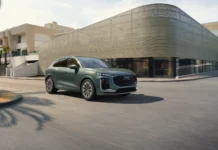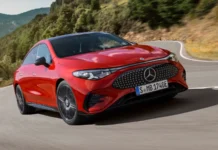
There are more EVs on the market today than ever before…but only a few qualify for the full $7,500 EV tax credit.
Tomorrow, April 18, most new electric vehicles you may be considering will lose access to the tax credit under new battery and raw material sourcing rules. We covered the Treasury Department’s guidance on the subject earlier this month, and while the Biden administration waxes lyrical about getting more drivers into EVs, the shrinking list of eligible models makes actually making that jump even more difficult than it’s been these past few months.
Reuters and other reports mention Treasury’s announcement Monday, noting several makes will lose access to the tax credit. BMW, Hyundai, Nissan, Rivian, Volkswagen and Volvo will no longer have any models on the eligible list. The rear-wheel drive Tesla Model 3 Standard Range will see its credit slashed by half, though at least its other models are still eligible for the full credit (under a certain MSRP ceiling, that is).
EVs eligible for $7,500 tax credit as of April 18, 2023: The short list
Out of more than 90 EV models in the U.S. market right now (counting multiple configurations within model lineups), just 10 qualify for the full $7,500 tax credit. Some further plug-in hybrids are eligible for a smaller $3,750 credit, but there’s one recurring theme among the short list contenders: They’re all American.
Keep in mind, even if you clear the “Sourced/Built in USA” hurdle, this is still means-tested. Passenger cars over $55,000 MSRP are automatically disqualified, as are any SUVs or trucks over $80,000. The latter is particularly important for vehicles like the Tesla Model S and X as well as higher trims of the Ford F-150 Lightning.
Even among American automakers, only General Motors’ entire EV lineup qualifies under the new rules. The U.S. Treasury Department confirmed all electric GM models would get the full tax credit Monday.
Here’s the current eligible list of full BEVs (italicized models have confirmed eligibility since TFL originally covered this story on April 18):
| Make and Model | Model Years | Credit Amount | MSRP Cap |
|---|---|---|---|
| Cadillac Lyriq | 2023-2024 | $7,500 | $80,000 |
| Chevrolet Blazer EV | 2024 | $7,500 | $80,000 |
| Chevrolet Bolt (including EUV) | 2022-2023 | $7,500 | $55,000 |
| Chevrolet Equinox EV | 2024 | $7,500 | $80,000 |
| Chevrolet Silverado EV | 2024 | $7,500 | $80,000 |
| Ford E-Transit | 2022-2023 | $3,750 | $80,000 |
| Ford F-150 Lightning | 2022-2023 | $7,500 | $80,000 |
| Ford Mustang Mach-E | 2022-2023 | $3,750 | $80,000 |
| Rivian R1S | 2022-2023 | $3,750 | $80,000 |
| Rivian R1T | 2022-2023 | $3,750 | $80,000 |
| Tesla Model 3 Performance | 2022-2023 | $7,500 | $55,000 |
| Tesla Model 3 Standard Range* | 2022-2023 | $3,750 | $55,000 |
| Tesla Model Y | 2022-2023 | $7,500 | $80,000 |
| Volkswagen ID.4 (confirmed 4/19/23) | 2022-2023 | $7,500 | $80,000 |

Update on the Volkswagen ID.4 and Rivian models
Earlier this week, information we had suggested the Volkswagen ID.4 would no longer be eligible — even U.S.-built models in Chattanooga, Tennessee. The automaker confirmed on April 19 the ID.4 is indeed eligible for the full credit. The full $7,500 amount applies to the ID.4 Standard models as well as the larger battery ID.4 Pro.
Rivian also confirmed its R1S SUV and R1T pickup would at least qualify for a $3,750 credit, provided the vehicle’s configuration does not exceed the $80,000 MSRP cap.
The plug-in hybrid list is (predictably shorter), and again only includes American cars:
| Make and Model | Model Years | Credit Amount | MSRP Cap |
|---|---|---|---|
| Chrysler Pacifica e-Hybrid | 2022-2023 | $7,500 | $80,000 |
| Ford Escape PHEV | 2022-2023 | $3,750 | $80,000 |
| Jeep Grand Cherokee 4xe | 2022-2023 | $3,750 | $80,000 |
| Jeep Wrangler 4xe | 2022-2023 | $3,750 | $80,000 |
| Lincoln Aviator Grand Touring | 2022-2023 | $7,500 | $80,000 |
| Lincoln Corsair Grand Touring | 2022-2023 | $3,750 | $80,000 |

All the formerly qualified EVs that don’t make the updated list
Even among U.S.-based automakers, the North America final assembly requirement on its own isn’t enough to keep eligibility for the tax credit. The battery guidance cut several models off, at least until those companies can realign their supply chains to largely (or later in the decade, entirely) source within North America or from one of its acceptable trading partners.
While some automakers have stayed quiet on the issue — GM, for its part, loudly exclaimed its vehicles would qualify — the government clarified these vehicles would no longer make the cut:
- Audi Q5 TSFI e-Quattro (PHEV)
- BMW 330e (PHEV)
- BMW xDrive45e (PHEV)
- Genesis Electrified GV70 (in addition to the GV70 and Electrified G80, which already didn’t qualify)
- Nissan Leaf (in addition to the Ariya, which is built in Japan for the U.S. market)
Rivian R1S(Rivian confirmed eligibility for a partial $3,750 credit on 4/20/23)Rivian R1T(Rivian confirmed eligibility for a partial $3,750 credit on 4/20/23)Volkswagen ID.4 (including U.S.-assembled models)(Volkswagen confirmed they would be eligible 4/19/23)- Volvo S60 Recharge (PHEV)

It’s still more complicated than that…
Clearly, American government officials from the president on down are going to push for EV buyers to fly the flag and buy American EVs. That was a huge part of the legislative intent here, as well as lawmakers’ vocal ambitions to break U.S. automakers’ tendency to source raw materials and components from China. That’s left most of the industry engaged in musical chairs, though, as companies like Hyundai Motor Group scramble to build factories in North America and revamp their supply chains to meet the new requirements.
What’s more, irrespective of your political leanings toward the Inflation Reduction Act, it leaves consumers with far fewer options should they actually want to take advantage of that tax credit. Will ineligible automakers cut prices to compete in the meantime? It’s difficult to say, as every company with skin in the game relies on those tax credits to boost sales.
Volkswagen said Monday it was “fairly optimistic” it would sort out supplier documentation issues that currently bar the ID.4 from being eligible. Nissan expressed a similar sentiment, saying it is working with suppliers to try and make the Leaf at least partially eligible.
One major consideration for the federal EV tax credit
Among the complex rules at play in determining whether the car you want can get the tax credit, there is one more important (though not new) consideration. Even if the car you want is eligible, you may still not get the full $3,750 or $7,500.
You would think the federal EV tax credit is a flat-rate incentive, but that is not quite the case. Getting the full amount assumes you have an income tax liability in the same amount or greater. So, to qualify for a $7,500 tax credit, you’d need to owe $7,500 or more in income taxes. If the credit amount reduces that tax liability to zero, you won’t see the remaining amount in a refund or be able to roll it over into the next year’s tax return.
The federal EV tax credit applies to individuals reporting an adjusted gross income (AGI) of $150,000 or less. That amount increases to $225,000 for heads of households, or $300,000 for joint filers.
Buying a used EV priced below $25,000 may still get you up to a $4,000 tax credit, but the income cap falls to $75,000 for individuals ($112,500 for head of household, $150,000 for joint filers). The vehicle also needs to be at least two calendar years old, and it only qualifies for the $4,000 credit once in its lifetime. In other words, you won’t get the credit if you buy a used EV from someone who’s already claimed the credit on that vehicle.























